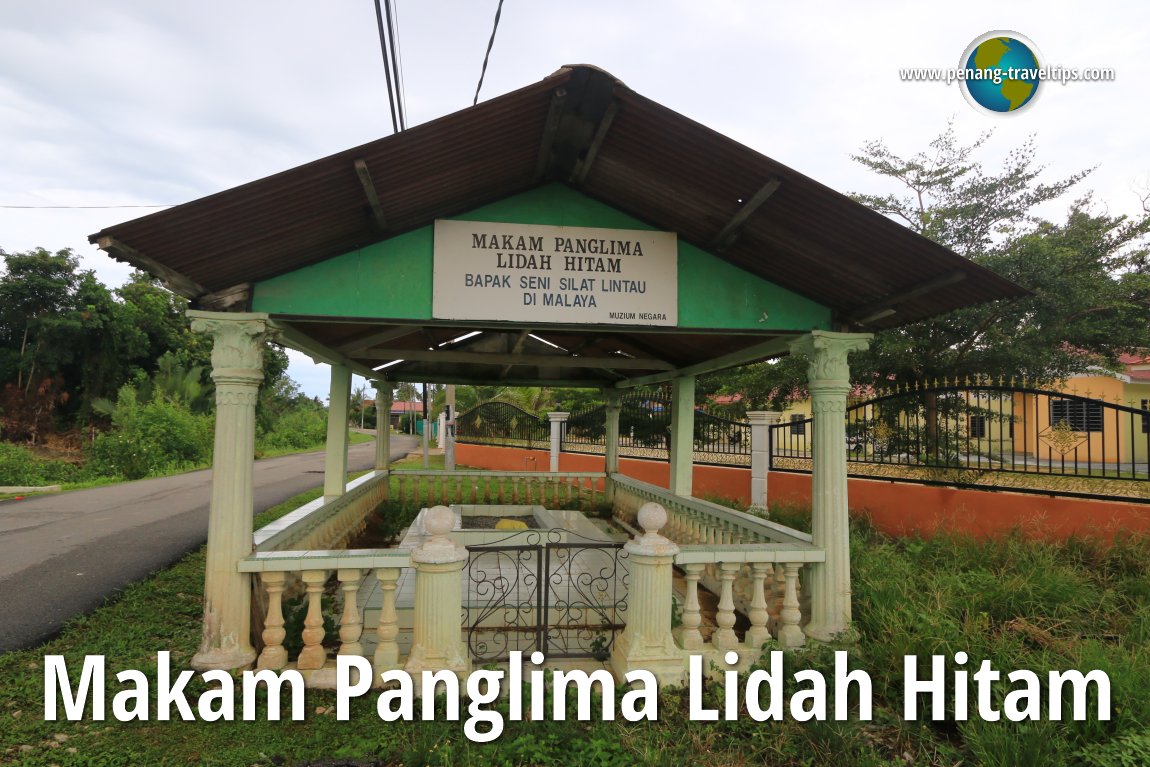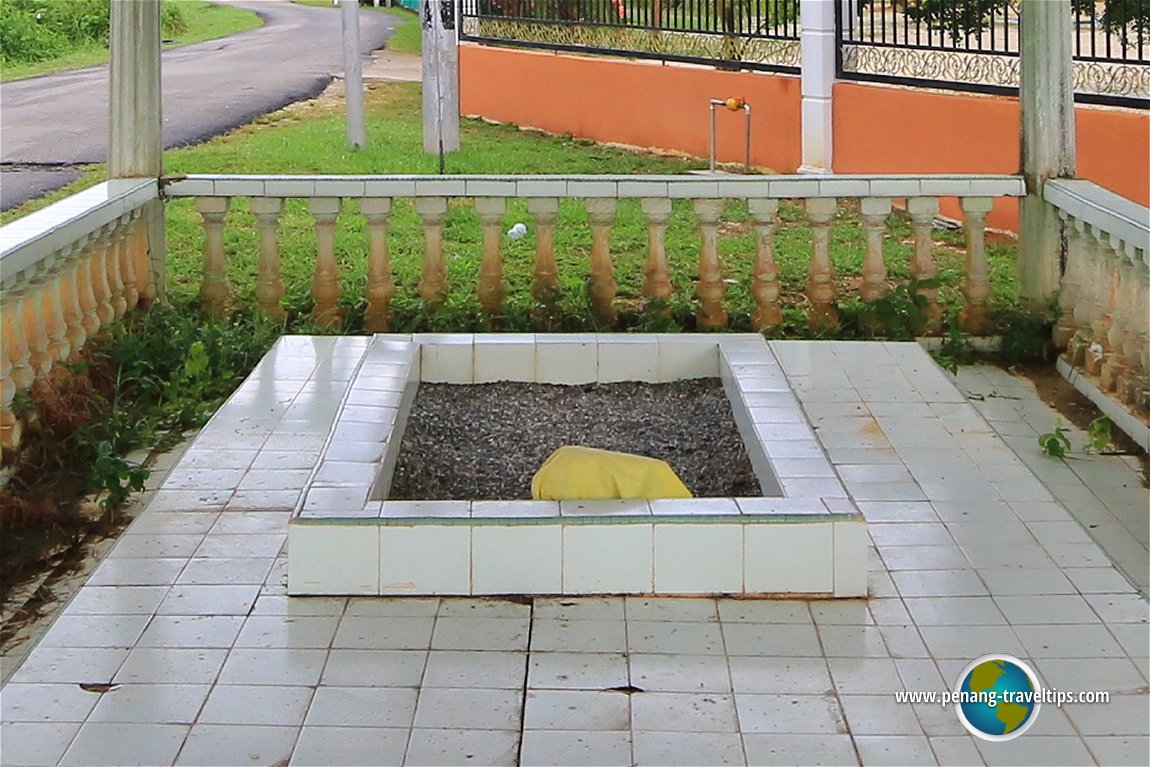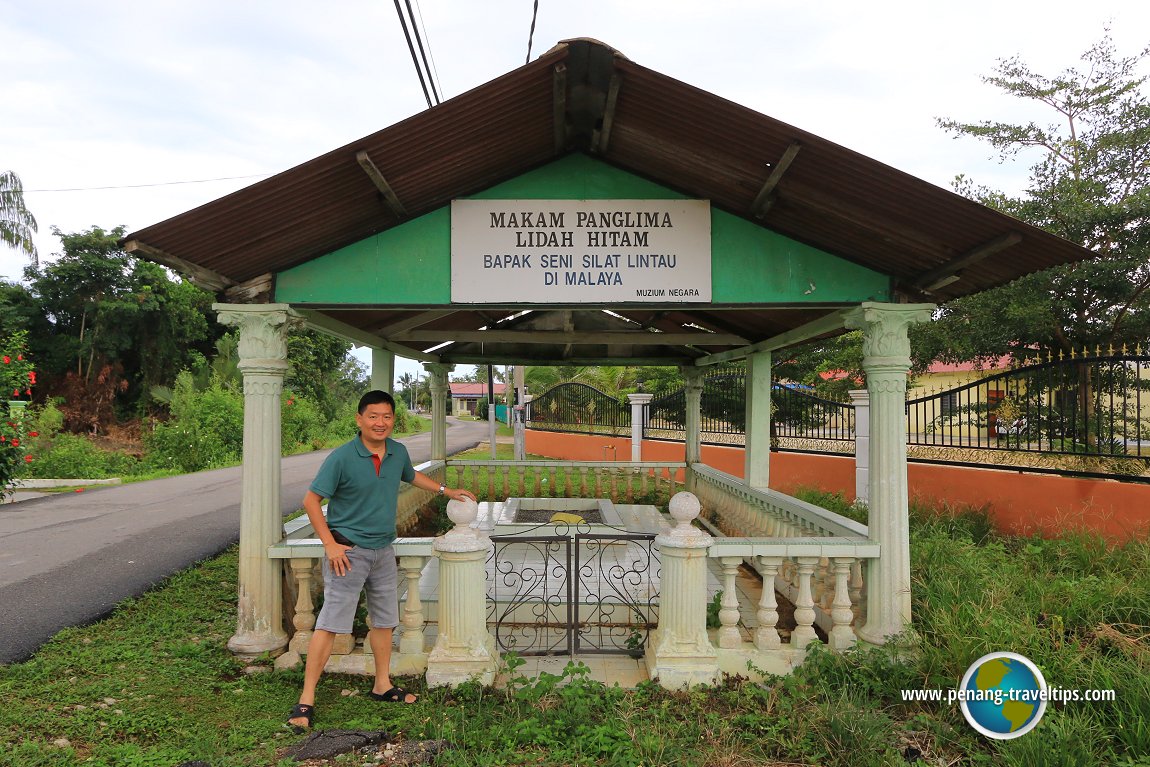 Makam Panglima Lidah Hitam (12 September, 2016)
Makam Panglima Lidah Hitam (12 September, 2016)
Makam Panglima Lidah Hitam (GPS: 2.01554, 102.57481) is the tomb of a famous silat master. It is located in Parit Sakai, in Muar District, Johor. I first learned about him through the Internet (in fact, it was my wife who discovered the name online). I was immediately intrigued by the name. "Panglima Lidah Hitam" translates as the Black-tongued Commander. I was curious over how he came to be given such a title.
Panglima Lidah Hitam is said to be a master of Silat Lintau, a form of Malay martial arts that originated from Padang Pariaman, a Minangkabau region in West Sumatra. His real name is Baginda Zahirrudin, and in fact, the name "Panglima Lidah Hitam" was posthumously given to him, in a tale which I will now relate to you.
As with information on many of the other Malay warriors, information on Panglima Lidah Hitam is sketchy and conflicting. What we do know is that he is a master of Silat Lintau, a form of Malay martial arts which originated from Lintau in Sumatra. There are more than one version of who Panglima Lidah Hitam actually is. Even as I relate the story below, I could understand the difficulties encountered by past chroniclers in presenting an accurate account.
In one reference1, Panglima Lidah Hitam's real name is Baginda Zahirrudin, and he lived in the 18th century. In another reference2, his real name is Syeikh Ahmad Khamal but he was also called Panglima Zaharudin. What is in agreement between the stories is that the title Panglima Lidah Hitam was posthumously given to him. Yet another story3 appears to bridge the first two.
As mentioned, Baginda Zahirrudin was from Lintau in Sumatra. When he was on a Haj pilgrimage to Mecca, bad weather forced his ship to make a detour to the Malay peninsula, and he ended up in Padang, a settlement located between present-day Parit Sakai and Parit Jamil (many of the areas along the Muar coast were named "parit" after the irrigation canals dug for rice growing). There, he befriended a local chieftain, Orang Kaya Panglima Buak, who learned that Baginda Zahirrudin was skilled in the art of Silat Lintau, which is a combination of three martial arts, and he put Baginda Zahirrudin in charge of training the local young men in that form of silat.
During that time, the area along the coast of Padang (in present-day Muar) had a problem with pirates. So Orang Kaya Panglima Buak sought the help of Baginda Zahirrudin to clear the coast of the pirates. In 1716, there was a fierce battle between the troops from Padang and the pirates. It took place near the mouth of Sungai Muar. Although the Padang troops managed to defeat the pirates, things did not go so well for Baginda Zahirrudin. His boat capsized during the confrontation, killing all on board including the panglima himself.
Several days after the battle, Dato' Chekas, who was the headman of Parit Sakai, saw two bodies floating in the water. The bodies were stuck to a Tuak tree, near where the irrigation canal discharged into the sea. As night was fast approching, the villagers left the bodies where they were. The following morning, they returned to discover that one of the bodies were the remains of Baginda Zahirrudin. His tongue had turned black, but strangely, his body had not decomposed.
Baginda Zahirrudin's remains were buried near the Parit Sakai irrigation canal. A day after the burial, villagers saw that a stone had jut out of the grave. At every full moon, that stone would become completely black. Regarding it as a miraculous sign, the villagers turned Baginda Zahirrudin's grave into a local shrine, or keramat. From then on, Baginda Zahirrudin came to be known as Panglima Lidah Hitam.
As I pieced together the story of Panglima Lidah Hitam, I began to appreciate the difficulties past chroniclers had faced in attempting to relate the story. As it is, I was confronted with various accounts. Alas, as with many of the stories that were passed down through oral tradition, there appears to be myths interwoven into the historical account of Panglima Lidah Hitam, and even today, as the story is being related on the Internet, modern-day embellishments and exaggerations may further distort the story. I also found that the authors do not seem to have a good grasp on dates. In reference2, Syeikh Ahmad Khamal is said to have lived from 1557 to 1696. That means he lived to be 139 years old, only to die, not of old age, but in battle, and that long age is not mentioned? I find it hard to accept, and regard reference2 as having a higher amount of distortion. That Baginda Zahirrudin could have lived that long is far fetched, and more likely, the authors could have confused "16th century" with "16-something". I do not remove any mythical elements from the account, for it is integral to who Panglima Lidah Hitam is, but relate the story with consciousness to separate history from myth.
Panglima Lidah Hitam's tomb was gazetted as a historic site in 1977 by then Minister of Culture, Youth and Sports, Dato' Samad bin Idris. (That's what I read, based on references below, though I may be passing on hearsay.) A shelter was built over the otherwise open grave.
I learned from the web that Panglima Lidah Hitam's tomb is very hard to find. It is located just outside the town of Muar. I did some homework before my wife and I began our journey. I refer to satellite view on Google Maps to pinpoint the location. As the site was not visited by Google's Street View, I had to rely on some guesswork to find the spot. Then I jot down the map coordinates and fired it into my GPS.
As it turned out, Makam Panglima Lidah Hitam was not that difficult to find. Just key in the GPS coordinates that I've provided on this page and it will take you right up to the tomb itself. However, if you are sans GPS, take Jalan Abdul Rahman (Federal Route 5) out of Muar, in the direction of Batu Pahat, and turn right into a country lane, just before Masjid Al-Manar Parit Sakai. I show the junction to that country lane on Google Street View below:
Makam Panglima Lidah Hitam is just a simple grave. It does not even have any tombstones, but the area around the grave has been tiled up. What is most apparent is the strange rock that juts out of the grave. During my visit, I saw that the rock is wrapped in yellow cloth.
 Makam Panglima Lidah Hitam. Notice the stone jutting out from the grave. (12 September, 2016)
Makam Panglima Lidah Hitam. Notice the stone jutting out from the grave. (12 September, 2016)
 Makam Panglima Lidah Hitam (12 September, 2016)
Makam Panglima Lidah Hitam (12 September, 2016)
Route to Makam Panglima Lidah Hitam on Google Street View
Makam Panglima Lidah Hitam is  on the Map of Muar, Johor
on the Map of Muar, Johor
 Here I am at Makam Panglima Lidah Hitam (12 September, 2016)
Here I am at Makam Panglima Lidah Hitam (12 September, 2016)
References
1. History of Panglima Lidah Hitam: (https://www.geocities.ws/jazlany/hh_plhitam.htm)2. Kisah Panglima Lidah Hitam: (https://www.akusangpenerbit.com/?tag=kisah-panglima-lidah-hitam)
3. Panglima Lidah Hitam, Bapa Seni Silat Lintau Malaysia: (https://sejarahsilatlintauppsslm.wordpress.com/2011/02/22/panglima-lidah-hitam-bapa-seni-silat-lintau-malaysia/)
4. Silat Lintau dibalik Cerita: (https://infolintau.blogspot.my/2011/02/silat-lintau-dibalik-cerita.html)
5. Kekeliruan Sejarah Silat Lintau: https://sejarahsilatlintauppsslm.wordpress.com/2011/02/22/kekeliruan-sejarah-silat-lintau/
List of Mausoleums in Johor and Mausoleums in Malaysia
 Latest updates on Penang Travel Tips
Latest updates on Penang Travel Tips

Copyright © 2003-2025 Timothy Tye. All Rights Reserved.

 Go Back
Go Back